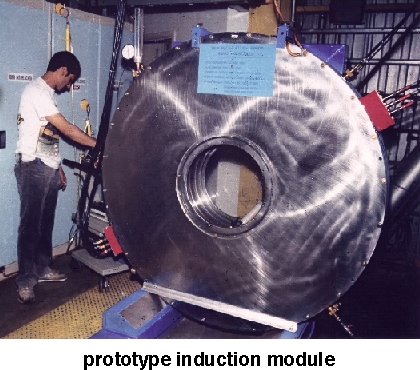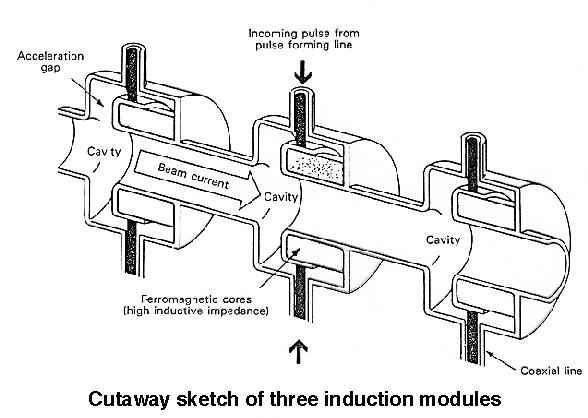Induction-Module Development The induction accelerator is the type of driver
preferred by the US heavy-ion fusion program. In
this device, a pulsed electric field along the
accelerator axis is induced by increasing the magnetic
flux in a ferromagnetic core encircling the beam
pipe. In effect, each core is a one-turn
transformer, with the beam acting as the secondary
winding. The pulser used to drive the magnetic
flux, the induction core, and the gap across which the
electric field is produced are together called an
induction module or, equivalently, an
induction cell. The induction-module
research at LLNL and LBNL has three main
objectives: designing relatively conventional
modules for near-term experiments like HCX, developing
advanced pulsers and module geometries, and improving
the performance of insulators and cores. The induction accelerator is the type of driver
preferred by the US heavy-ion fusion program. In
this device, a pulsed electric field along the
accelerator axis is induced by increasing the magnetic
flux in a ferromagnetic core encircling the beam
pipe. In effect, each core is a one-turn
transformer, with the beam acting as the secondary
winding. The pulser used to drive the magnetic
flux, the induction core, and the gap across which the
electric field is produced are together called an
induction module or, equivalently, an
induction cell. The induction-module
research at LLNL and LBNL has three main
objectives: designing relatively conventional
modules for near-term experiments like HCX, developing
advanced pulsers and module geometries, and improving
the performance of insulators and cores.
Pulser design involves a trade-off between
flexibility and cost. For a fusion driver,
pulsers should ideally have high peak power, a 5-10 Hz
repetition rate, agile waveform control, and a
production cost less than $20/J. The least
expensive type of pulser consists of a passive
pulse-forming network (PFN) switched by a
sparkgap. This type of pulser, however, has poor
waveform control and a relatively short spark-gap
lifetime (~105 shots). Replacing the
spark gap with a thyratron increase the lifetime
(~106 - 107shots), but the cost
is substantially higher, and there is still little
wavefrorm flexibility. Solid-state pulser are
being studied, despite their even higher cost, because
they offer high reliability and long liftetime, as well
as allowing programmable waveforms. Under a
small-business research contract, Diversified Technologies
has investigated the use of low-inductance
Insulated-Gate Bipolar Transistors (IGBTs) for
switching, followed by magnetic pulse compression, and
has reported that such a hybrid system could meet
the performance requirements of a fusion
driver. Also, on a separate small-business
contract, First Point Scientific is developing a
solid-state pulser which will add corrections with a
voltage up to 20 kV to waveforms generated by more
traditional pulsers, allowing more accurate control of
the beam longitudinal profile. When complete,
this pulser will be tested on HCX.
Research into core materials and fabrication
techniques is being carried out in parallel with pulser
design. During the last five years, many
amorphous and nanocrystalline iron-based alloys have
been tested for their magnetic properties, uniformity,
and ease of fabrication. To minimize losses,
cores made from these materials must be built up in
thin (~2 x 10-5 m) layers, and each layer
must be insultated to prevent current flow across
them. Cores are typically fabricated by casting
or rolling the material into a thin ribbon, coating it
with insulation, and winding the ribbon onto a
spool. At present, amorphous materials are the
least expensive, but available insulating materials
that can survive the annealling process are either too
thick, degrade performance, or do not hold sufficient
voltage. Silicon steel is more expensive and has
high losses, but it is an alternative for longer pulse
durations due to its higher magnetic-flux swing.
Nanocrystalline steel is also more expensive than
amorphous materials and produces a lower voltage for a
given core size, but it is attractive for applications
where low core losses are important.
For comments or questions contact WMSharp@lbl.gov or DPGrote@lbl.gov. Work described here was supported by the Office of Fusion Energy at the US Department of Energy under contracts DE-AC03-76SF00098 and W-7405-ENG-48. This document was last revised June, 2002. |

 The
work on advanced induction-module designs is aimed at
increasing the maximum voltage gradient across the
gap. The principal limitation on cell voltage is
electrical breakdown across the insulators, so
improved insulator materials are being investigated as
a way to increase the cell voltage. The
requirements for insulators are stringent, including a
surface-breakdown strength of 100 kV/cm, compatibility
with ultra-high vacuum (10-8 Torr), and high
mechanical strength. Nonetheless, recent tests of
Mycalex, layered insulators, and glass insulators show
promise, although these materials may exceed the $10/kV
production-cost target. Another approach to
increasing cell voltage is to design vacuum-insulated
induction modules with long radial insulators.
The principal questions about this approach are whether
a suffiently good vacuum can be achieved in an
accelerator to hold the required voltage and whether
heat generated by the cores can be dissipated.
The HIF-VNL is considering construction of an
induction-cell test stand both to examine major issue
of the vacuum-insulated cell concept and to test
various core configurations, insulator materials, and
cell geometries.
The
work on advanced induction-module designs is aimed at
increasing the maximum voltage gradient across the
gap. The principal limitation on cell voltage is
electrical breakdown across the insulators, so
improved insulator materials are being investigated as
a way to increase the cell voltage. The
requirements for insulators are stringent, including a
surface-breakdown strength of 100 kV/cm, compatibility
with ultra-high vacuum (10-8 Torr), and high
mechanical strength. Nonetheless, recent tests of
Mycalex, layered insulators, and glass insulators show
promise, although these materials may exceed the $10/kV
production-cost target. Another approach to
increasing cell voltage is to design vacuum-insulated
induction modules with long radial insulators.
The principal questions about this approach are whether
a suffiently good vacuum can be achieved in an
accelerator to hold the required voltage and whether
heat generated by the cores can be dissipated.
The HIF-VNL is considering construction of an
induction-cell test stand both to examine major issue
of the vacuum-insulated cell concept and to test
various core configurations, insulator materials, and
cell geometries.